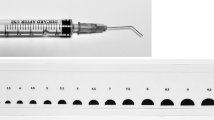Abstract
Purpose
There is a large variation in mydriatic regimens used in screening for retinopathy in preterm infants. Except for the standard instillation of mydriatic drops in their commercial formulation, other techniques for pupil dilation have also been described. This study aimed to review all techniques that have been used for mydriasis in retinopathy of prematurity eye examination (ROPEE) screening.
Methods
A comprehensive literature search was performed in PubMed, Cochrane library, Trip database, and Scopus, using the key words: “mydriasis”, “techniques”, “mydriatics”, “dilating drops”, “retinopathy of prematurity”, “ROP”, “phenylephrine”, “cyclopentolate”, “tropicamide”, “smaller mydriatic drops”, “reduction in drop size” to February 2019.
Results
Five primary studies were included, assessing the techniques of microdrops, lower conjunctival fornix (LCF) packing and Mydriasert® ophthalmic insert. Reported efficacy was similar to commercial eyedrops instillation. Microdrops appeared to have a superior safety profile. LCF packing and Mydriasert lead to increased blood pressure, without serious complications, necessitating further safety studies.
Conclusions
Of all alternative mydriasis techniques for ROPEE screening that have been described, microdrops appear to be the safest yet still effective technique in the fragile population of premature infants in risk of ROP.


Similar content being viewed by others
Availability of data and materials
Not applicable.
References
Kremer LJ, Reith DM, Medlicott N, Broadbent R (2019) Systematic review of mydriatics used for screening of retinopathy in premature infants. BMJ Paediatr Open 3(1):e000448. https://doi.org/10.1136/bmjpo-2019-000448
Higgins JPT, Altman DG, Gøtzsche PC, Jüni P, Moher D, Oxman AD et al (2011) The Cochrane collaboration’s tool for assessing risk of bias in randomised trials. BMJ 343:d5928. https://doi.org/10.1136/bmj.d5928
Wells G, Shea B, O'Connell D, Peterson J, Welch V, Losos M et al (2014) The Newcastle-Ottawa Scale (NOS) for assessing the quality of nonrandomised studies in meta-analyses. Ottawa Health Research Institute Web site. https://www.ohri.ca/programs/clinical_epidemiology/oxford.asp. Accessed 20 Aug 2019
Deeks JJ, Dinnes J, D’Amico R, Sowden AJ, Sakarovitch C, Son F et al (2003) Evaluating non-randomised intervention studies. Health Technol Assess 7(27):1–173. https://doi.org/10.3310/hta7270
Lynch MG, Brown RH, Goode SM, Schoenwald RD, Chien S (1987) Reduction of phenylephrine drop size in infants achieves equal dilation with decreased systemic absorption. Arch Ophthalmol 105(10):1364–1365. https://doi.org/10.1001/archopht.1987.01060100066027
Wheatcroft S, Sharma A, McAllister J (1993) Reduction in mydriatic drop size in premature infants. Br J Ophthalmol 77(6):364–365. https://doi.org/10.1136/bjo.77.6.364
Elibol O, Alçe T, Yüksel N, Çaĝlar Y (1997) The influence of drop size of cyclopentolate, phenylephrine and tropicamide on pupil dilatation and systemic side effects in infants. Acta Ophthalmol Scand 75(2):178–180. https://doi.org/10.1111/j.1600-0420.1997.tb00119.x
Thanathanee O, Ratanapakorn T, Morley MG, Yospaiboon Y (2012) Lower conjunctival fornix packing for mydriasis in premature infants: a randomized trial. Clin Ophthalmol 6:253–256. https://doi.org/10.2147/OPTH.S28714
Bremond-Gignac D, Jacqz-Aigrain E, Abdoul H, Daruich A, Beresniak A, Baud O, Alberti C (2019) Ophthalmic insert versus eye drops for mydriasis in neonates: a randomized clinical trial. Neonatology 115(2):142–148. https://doi.org/10.1159/000493723
Funding
The authors received no financial support for this submission.
Author information
Authors and Affiliations
Contributions
All authors have made substantive intellectual contributions to this study. All authors (AKS, EP, ML, SK, NZ, VS and AM) contributed to the conceptualization of the manuscript, overview of literature and interpretation of data. AKS and AM contributed to the design of this work. AKS, AM, EP and ML contributed to data acquisition and extraction. AKS, AM, EP prepared the draft manuscript of this review. EP, AKS, AM prepared the methodological quality assessment. All authors reviewed and approved the final version of the manuscript.
Corresponding author
Ethics declarations
Conflict of interest
The authors have no conflicts of interest to declare.
Ethical approval
Not applicable.
Code availability
Not applicable.
Consent to participate
Not applicable.
Consent for publication
Not applicable.
Additional information
Publisher's Note
Springer Nature remains neutral with regard to jurisdictional claims in published maps and institutional affiliations.
Rights and permissions
About this article
Cite this article
Seliniotaki, A.K., Prousali, E., Lithoxopoulou, M. et al. Alternative mydriasis techniques for retinopathy of prematurity screening. Int Ophthalmol 40, 3613–3619 (2020). https://doi.org/10.1007/s10792-020-01542-x
Received:
Accepted:
Published:
Issue Date:
DOI: https://doi.org/10.1007/s10792-020-01542-x




